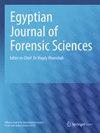钝性胸部创伤诱发心肌梗死:一例凶杀猝死病例
IF 1.3
Q3 MEDICINE, LEGAL
引用次数: 0
摘要
钝性心脏损伤通常是钝性胸部创伤造成的,在临床上并不特别严重。绝不能低估胸部钝伤,尤其是发生在前胸部位的钝伤。胸部钝伤是心肌梗死(MI)最罕见的致病因素之一。钝性心脏损伤包括不同的医疗紧急情况,如心肌逐渐损伤导致心肌缺血、心脏大血管损伤、心包填塞、室间隔或室壁破裂、泵衰竭、传导异常以及心房和心室颤动。钝性胸部创伤最常见的原因是道路交通事故(RTA),其次是运动损伤。钝性胸部外伤大多发生在 45 岁以下年龄组。一名 45 岁的男性被邻居带到急诊科,他有过人身攻击史。据称,他在一次争吵中被亲戚踢到胸部,胸部受到钝器击打,当即昏迷。入院后,对他进行了心肺复苏,并宣布死亡。尸检结果显示,胸部没有外伤迹象,也没有任何鞋印/脚印。在组织病理学检查中,发现了与大面积心肌梗死一致的弥漫性变色区域。左心室游离壁、左后乳头肌和左心尖可见陈旧性愈合的梗死。冠状动脉出现粥样斑块,管腔狭窄,并有局灶性钙化。法医病理学家的任务是确定并记录证据,以确定心肌梗死是否是在尸检过程中胸部受到所谓的钝器创伤造成的。这一点非常重要,因为它将决定被告可能被指控的罪名类型以及根据《印度刑法典》可能受到的处罚程度。本文章由计算机程序翻译,如有差异,请以英文原文为准。
Blunt chest trauma-induced myocardial infarction: a case of sudden death by homicide
Blunt cardiac injuries, which are typically the result of blunt chest trauma, are not particularly significant clinically. It is vital never to underestimate blunt chest injuries, especially when they occur in the anterior thoracic area. Blunt trauma to the chest is one of the rarest causative factors of myocardial infarction (MI). Blunt cardiac injury encompasses different medical emergency conditions such as gradual damage to the myocardium leading to myocardial ischemia, injuries to the great vessels of the heart, pericardial tamponade, septum or wall ruptures, pump failure, conduction abnormalities, and atrial and ventricular fibrillations. The most common cause of blunt chest trauma is a road traffic accident (RTA), followed by a sports injury. Mostly blunt trauma chest injuries occur below the age group of 45 years. A 45-year-old male with a history of physical assault was brought to the emergency department by his neighbor. He was allegedly kicked by his relative over the chest during an altercation sustained blunt-force trauma to the chest and collapsed immediately. On admission, he was given cardiopulmonary resuscitation and declared dead. On autopsy, there were no signs suggestive of external injury or any shoeprints/footprints on the chest. On histopathological examination, a diffuse area of discoloration consistent with an extensive myocardial infarction was noted. Old healed infarcts were seen in the free wall of the left ventricle, left posterior papillary muscle, and left apex. The coronaries showed atheromatous plaque with lumen narrowing and focal calcification. It is the task of the forensic pathologist to ascertain and record evidence as to whether the myocardial infarction was caused by the alleged blunt trauma to the chest during the autopsy. This is important as it will determine the type of prosecution the accused is likely to be charged with and the extent of the punishment that he will likely receive under the Indian Penal Code.
求助全文
通过发布文献求助,成功后即可免费获取论文全文。
去求助
来源期刊

Egyptian journal of forensic sciences
MEDICINE, LEGAL-
CiteScore
2.00
自引率
0.00%
发文量
51
审稿时长
17 weeks
期刊介绍:
Egyptian Journal of Forensic Sciences, the official publication of The International Association of Law and Forensic Sciences (IALFS), is an open access journal that publishes articles in the forensic sciences, pathology and clinical forensic medicine and its related specialities. The journal carries classic reviews, case studies, original research, hypotheses and learning points, offering critical analysis and scientific appraisal.
 求助内容:
求助内容: 应助结果提醒方式:
应助结果提醒方式:


